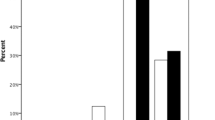Abstract
Background
Corneal ectasia after photorefractive keratectomy (PRK) has only been occasionally reported, and its incidence has not been assessed.
Methods
In a retrospective, non-comparative case series, incidence of corneal ectasia was evaluated in a personal consecutive 6453-case series of myopic PRK with a minimum follow-up of 18 months. Features and prognosis were evaluated in all patients with ectasia after PRK (in both personal and referred cases).
Results
Ectasia was detected in three eyes of two patients (patients 1 and 2) 3 years and 1 year after PRK performed elsewhere. In addition, in the personal PRK series, two eyes of two patients (patients 3 and 4) developed corneal ectasia 5 months after surgery (incidence: 0.03%). Pre-operatively, forme fruste keratoconus was present in patients 1, 3 and 4; keratoconus in the fellow eye in patient 2; pachymetry <500 micron in patients 2 and 3. In patient 1, rigid contact lenses were prescribed, and in patient 2 deep anterior lamellar keratoplasty was needed; in patients 3 and 4, low induced astigmatism resulted, requiring driving spectacles in patient 3.
Conclusions
PRK induced corneal ectasia in predisposed eyes, even after low myopic ablations. Forme fruste keratoconus and keratoconus in the fellow eye were the main pre-operative findings. Prognosis varies according to severity.




Similar content being viewed by others
References
Pallikaris IG, Kymionos GD, Astyrakakis NI (2001) Corneal ectasia induced by laser in situ keratomileusis. J Cataract Refract Surg 27:1796–1802
Randleman JB, Russell B, Ward MA, Thompson KP, Stulting RD (2003) Risk factors and prognosis for corneal ectasia after LASIK. Ophthalmology 110:267–275
Rao SN, Epstein RJ (2002) Early onset ectasia following laser in situ keratomileusis: case report and literature review. J Refract Surg 18:177–184
Geggel HS, Talley AR (1999) Delayed onset keratectasia following laser in situ keratomileusis. J Cataract Refract Surg 25:582–586
Doyle SJ, Hynes E, Naroo S, Shah S (1996) PRK in patients with a keratoconic topography picture. The concept of a physiological ‘displaced apex syndrome’. Br J Ophthalmol 80:25–28
Bilgihan K, Ozdek SC, Konuk O, Akata F, Hasanreisoglu B (2000) Results of photorefractive keratectomy in keratoconus suspects at 4 years. J Refract Surg 16:438–443
Lovisolo CF, Fleming JF (2002) Intracorneal rings segments for iatrogenic keratectasia after laser in situ keratomileusis or photorefractive keratectomy. J Refract Surg 18:535–541
Parmar D, Claoue C (2004) Keratectasia following excimer laser photorefractive keratectomy. Acta Ophthalmol Scand 82:102–105
Chiou AG, Bovet J, de Courten C (2006) Management of corneal ectasia and cataract following photorefractive keratectomy. J Cataract Refract Surg 32:679–680
Malecaze F, Coullet J, Calvas P, Fournié P, Arné JL, Brodaty C (2006) Corneal ectasia and after photorefractive keratectomy for low myopia. Ophthalmology 13:742–746
Holland SP, Srivannaboon S, Reinstein DZ (2000) Avoiding serious corneal complications of laser assisted in situ keratomileusis and photorefractive keratectomy. Ophthalmology 107:640–652
Randleman JB, Caster AI, Banning CS, Stulting RD (2006) Corneal ectasia after photorefractive keratectomy. J Cataract Refract Surg 32:1385–1398
Comaish IF, Lawless MA (2002) Progressive post-LASIK keratectasia. Biomechanical instability or chronic disease process? J Cataract Refract Surg 28:2206–2213
Rao SK, Srinivasan B, Sitalakshmi G, Padmanabhan P (2004) Photorefractive keratectomy versus laser in situ keratomileusis to prevent keratectasia after corneal ablation. J Cataract Refract Surg 30:2623–2628
Author information
Authors and Affiliations
Corresponding author
Additional information
The author has no financial or proprietary interest in any product or technique mentioned. The author has full control of all primary data, and agrees to allow Graefes Archive for Clinical and Experimental Ophthalmology to review the data upon request.
Rights and permissions
About this article
Cite this article
Leccisotti, A. Corneal ectasia after photorefractive keratectomy. Graefe's Arch Clin Exp Ophthalmol 245, 869–875 (2007). https://doi.org/10.1007/s00417-006-0507-z
Received:
Revised:
Accepted:
Published:
Issue Date:
DOI: https://doi.org/10.1007/s00417-006-0507-z




